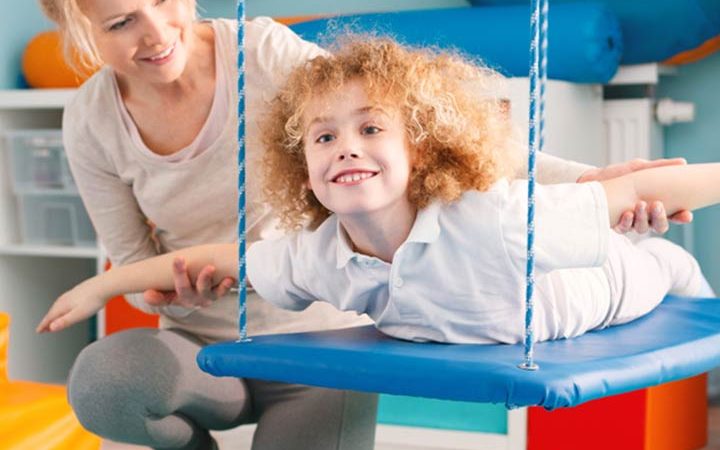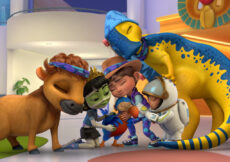Occupational therapy (OT) is a treatment for problems associated with movement and coordination. It helps improve several skills that are needed to carry out everyday tasks, such as writing and getting dressed.
These skills include fine and gross motor skills, motor planning, coordination, balance, and self-regulation skills.
Read the post to learn more about the benefits of occupational therapy for children and conditions where occupational therapy would help a child.
Who Might Need Occupational Therapy?
According to the University of Utah Health, pediatric occupational therapy is needed when a child has problems in the following areas of development:
1. Developmental delays
- Delay in developing age-appropriate play and social skills
- Inability to learn at an age-appropriate level
- Delay in sitting, crawling, and walking
2. Fine motor skills
- Buttoning and unbuttoning
- Tying and untying shoelaces
- Coloring, writing, drawing, tracing, etc.
- Forming letters or numbers
- Showing lack of interest in or avoiding activities that require fine motor skills
3. Gross motor skills
- Climbing and descending stairs
- Coordinating both sides of the body
- Difficulty differentiating between the left and right sides
- Poor balance and coordination
- Fearful of the feet leaving the ground
- Does not cross the midline of their body while playing or performing tasks
- Avoiding games and tasks that need gross motor skills
4. Visual processing
- Problems with spacing, identification, and size of letters
- Problems with copying or identifying shapes or letters
- Difficulty finding objects
5. Oral motor/ oral sensory
- Using the front teeth instead of the molars to chew food
- Inability to use a cup at an age-appropriate time
- Tiredness after a meal or snack
- Excessively picky when eating
6. Sensory processing
- Highly sensitive to sound, touch, or movement
- Less sensitive to some sensations (high tolerance to cuts, bruises, etc.)
- Constantly moving, jumping, crashing, etc.
- Difficulty adjusting to changes
- Easily distracted by stimuli
7. Social interaction skills
- Problems in interacting with family and peers
- Problems in adapting to new environments
- Delays in language development
- Overly focused in particular areas
- Difficulty coping in the school environment
8. Learning challenges
- Problems with concentration and focus at school
- Problems with following instructions
- Easily gets tired at school
- Low energy or hyperactive
- Difficulty learning new things
Benefits Of Pediatric Occupational Therapy
The following are the benefits of occupational therapy for children.
- Helps with sensory management
- Allows children to engage in play and other activities
- Develops their skills to adapt to any changes in the environment
- Helps them become more focused
- Helps them practice appropriate social interactions and communication
- Helps them perform tasks independently, such as brushing teeth and combing hair.
What Happens In Pediatric Occupational Therapy?
Occupational therapy is designed for each child based on their individual needs. First, the therapist understands the strengths and weaknesses of the child to design a set of exercises and activities that focuses on strengthening the child’s weak motor skills.
For example, activities such as picking things with tweezers might be added to the plan to improve the child’s fine motor skills, while jumping jacks or running an obstacle course might be suggested to improve the child’s gross motor skills.
In addition, the therapist might also include routine activities such as buttoning a shirt, zipping up pants, or getting dresses to help with motor planning. These can help create predictable schedules by marking initial steps and the following sequence of tasks to help the child do things independently.
All in all, occupational therapy aims at improving children’s cognitive, physical, social, and motor skills and enabling them to become more independent.
Where Do Occupational Therapists Work?
Occupational therapists are found in many different setups. Some private service providers may visit young children at home and school to provide therapy, and in some settings, occupational therapists are made available in private sensory gyms.
In most cases, pediatric occupational therapists work at schools. They help children with learning and fine motor skills inside the classroom and work on their gross motor skills outside of the classrooms.
How To Explain Occupational Therapy To A Child?
It is vital that you explain to children the purpose and goals of occupational therapy to avoid confusion. A child who understands the purpose of occupational therapy well will be able to freely convey the struggles they face in their day-to-day life to the occupational therapist.
Tell your child that they would get to do fun things such as scooping mud into a bucket and swaying in a huge swing. You could ask your child’s therapists about the planned activities in the upcoming session and prepare your child for it. Make it sound fun for them and convey to them that OT will help them become more independent in life.
Occupational therapy helps children perform routine tasks and enables them to learn essential life skills. Your pediatrician can help you determine if your child needs occupational therapy. You may also ask the school authorities if they provide occupational therapy before enrolling your child in a school.
References:
MomJunction’s articles are written after analyzing the research works of expert authors and institutions. Our references consist of resources established by authorities in their respective fields. You can learn more about the authenticity of the information we present in our editorial policy.



































